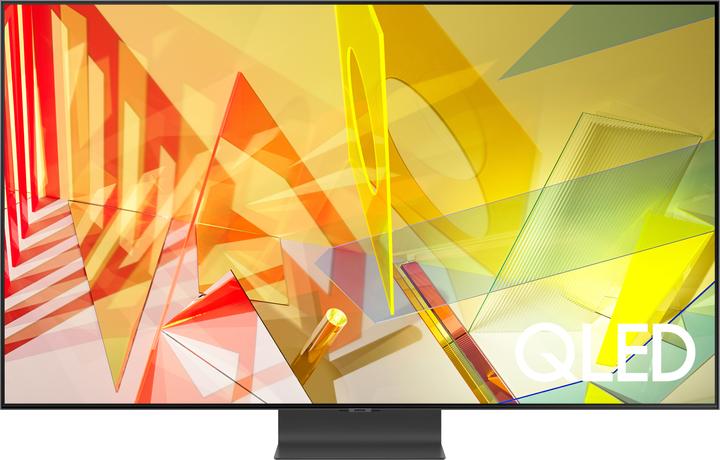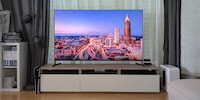
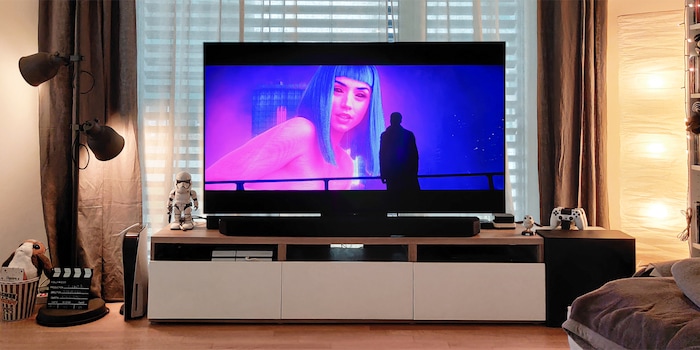
Samsung Q95T review: strong image with wasted potential
In terms of LCDs, the Samsung QLED flagships have been the front-runners for years. And rightfully so. But… this time it seems like they might have thrown away their potential.
It’s been almost two years now since my last Samsung TV review. Wow. Is it really that long? At the time, I wondered why Samsung was launching an 8K TV when there wasn’t any proper 8K content yet. But now, all the manufacturers have jumped on the 8K TV bandwagon. I still have the same question about 8K content – it’s not been answered. And I’m still critical.
Don't be annoyed with me, Samsung.
The UHD flagship is still up-to-date, not to be sneezed at and costs a lot less. It answers to the name of Q95T, is based on LCD QLED technology and made my day, or rather month, over the holidays.
Let’s jump straight in and see what this TV has to offer.
QLED, OneConnect box and design
We’ll begin with a quick warm-up. QLED is a byword for Samsung’s «Quantum Dots», which is a kind of image technology based on nanoparticles. These are particles in the lower layers of the TV panel that emit blue LED background light and transform it into a white light. In this way, the red, green and blue subpixels in the overlying layers can create much purer colours than traditional LCD TVs. This is what makes QLED such a cut above the rest.
The name «QLED» is just marketing, even if Samsung doesn’t like to be told that. But the fact is, other manufacturers have the same technology – only they call it something else. Sony calls it «Triluminos». Meanwhile, LG calls it «Nanocell». Samsung’s trick is that their nanoparticle technology can easily be mistaken with main competitor technology «OLED» because of the «Q» in the name.
However, the fact that the competitors, apart from OLED, use the same nanoparticles doesn’t mean they all handle the technology as well. As it happens, I prefer Samsung’s nanoparticle LCD TVs. In terms of contrast, they’re not as far from OLED as the others.
Most of the time, at least.
The Q95T that I’m reviewing comes with a One Connect box, which is a separate hub for connecting external ports. There’s just a single, almost invisible cable that connects the One Connect box to the TV and provides power to the screen. So, if you want an elegant solution, you can hide the box away in a drawer within your TV unit along with the cable spaghetti.
How convenient is that?
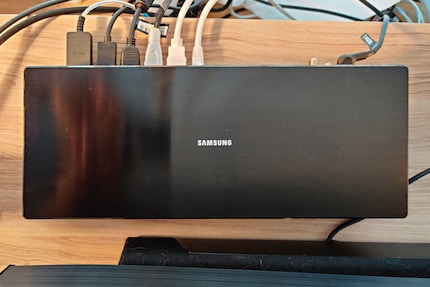
The OneConnect box has the following connections:
- 3× HDMI 2.0b ports
- One with ARC
- 1× HDMI 2.1 port (4K 120Hz, VRR & ALLM)
- Input lag: very good, 10.2 ms in game mode
- All inputs support HLG, HDR10 and HDR10+
- No Dolby Vision. But the TV can send Dolby Atmos back to an Atmos-compatible external soundbar or receiver.
- 2× USB 2.0 ports
- 1× Toslink output
- 1× LAN port
- Antenna ports
As far as design goes, Samsung knows how to impress. The Q95T is clean, modern and modest. If you look at the image straight on, the aluminium screen edge is a mere 3 mm thick. That’s almost non-existent. As though the image was just floating in the room. The panel itself is slightly thicker at 3 cm.
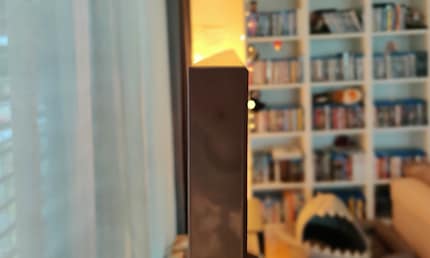
The same panel has a single stand that’s placed in the middle. It’s about 8.5 cm from the lower screen edge and the area the TV is on. In other words, enough space for a soundbar.
Perfect. Now let’s turn our attention to the UHD image.
Crisp UHD image with a red tinge
We couldn’t gloss over the epic dinosaur film «Jurassic World: Fallen Kingdom» now, could we? It’s a Luca tradition in TV reviews. I've seen this film on so many different TVs that I can easily tell what I like about the image, where I spot the imperfections and what it excels at.
Here's the first scene.
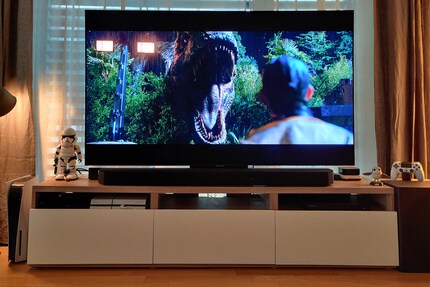
Source: UHD Blu-ray, HDR10 quality. Timestamp: 00:05:07
It’s a night scene, so the processor – the brain of the TV – has to make sure that black is showing as jet-black and not washed-out grey. For instance, in the background where you see the night sky. But it also shouldn’t swallow up any of the details. At the same time, there are a few extremely bright areas of the image that can’t be faint. I’m thinking the light in the top left, for starters. Or the jaws of the T-Rex and the yellowish raincoat of the poor man who’s about to get eaten.
For a dark scene, this one isn’t at all easy for TV processors to get right. Balance is key here. A true tightrope walk. It’s enough to push any processor to its limits.
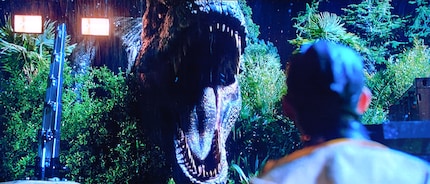
Source: January 2021
OK, so there’s a slight red tinge in the image. But it’s minimal and not too bad. What I particularly like are the details. The tongue ridge, for example, or the razor-sharp teeth. Although the image is, as is typical of LCDs, slightly too bright for my liking. That’s in spite of full array local dimming (FALD). In layman’s terms, that means the backlight comes from hundreds of LEDs all lined up next to each other. Depending on the model, the LEDs then group themselves together in sets of a couple of dozen to create dimming zones.
In the case of the Q95T, there are 120 dimming zones (link in German). As is the case on OLED TVs, these zones can also be dimmed or switched off locally. This ensures dark image areas are darkened and light areas brightened in a targeted way. Especially when it comes to scenes like the one above. What’s all the more surprising is that this particular scene looks faint in spite of FALD. Let’s compare it with a Philips OLED TV for a moment.
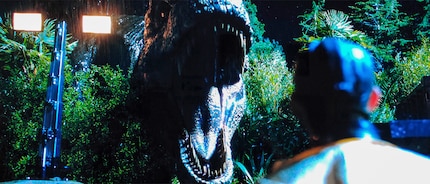
Source: November 2020
This image packs a lot more punch.
What’s interesting is that Samsung only included half as many dimming zones in the Q95T compared with the Q90R, the previous model from the year before. Unfortunately, I wasn’t able to test that one out, so I can’t draw any direct comparisons. According to some reviews, Samsung is supposed to have improved the FALD algorithm to such an extent that the Q95T has even less blooming than its predecessor. I’m surprised. It’s normally the case that the more individually controllable dimming zones there are, the less blooming occurs. So Samsung must have done a good job.
If you're still wondering what blooming is, all will be revealed shortly.
Critics have accused Samsung of intentionally including fewer dimming zones in their UHD flagship to make their 8K FALD TV look more impressive, as it has 500 dimming zones. The aim was supposedly to try and convince undecided buyers to opt for the almost twice as expensive Q950T.
I’m sticking with «no comment». Right, next scene.
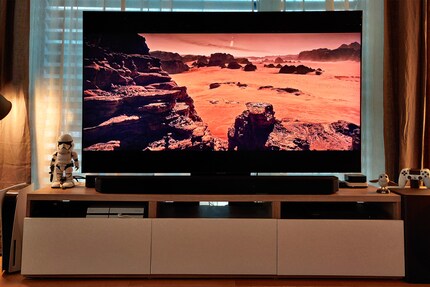
Source: UHD Blu-ray, HDR10 quality. Timestamp: 00:42:18
In Ridley Scott’s «The Martian», there are outdoor scenes like this galore. The blazing sun is responsible for the extremely bright scenes in the rugged wasteland of Mars. Especially fascinating are the barren rock formations in the middle of the endless dune sea, winding around the rocks in all possible shades of red and orange.
The scene is basically the opposite of the T-Rex one. There are also differences in brightness that bring TV processors out in a sweat. But in this case, it’s a bright scene with not many dark image areas on the rocks that’s challenging for the processor.
Let's take a closer look.

Source: January 2021
And now Philips OLED 805:

Source: November 2020
There it is again, the red tinge. It’s difficult to ignore. The wasteland should be a lot more orange on the Samsung TV. The Philips image has a much better handle on colour accuracy. But the QLED barely has any issues with «black crush» – the loss of detail in dark areas of the picture. That’s a flaw I’d already pointed out in the Philips TV review.
Before you read too much negativity into this, the red tinge isn’t bothersome if you don’t have a direct comparison. But you do notice it when you’re on the lookout for it. Or if you know what a scene should actually look like.
Take this one here, for instance – again from «Jurassic World»:

Source: January 2021
I like how balanced and natural the image looks. You hardly lose any details – certainly not around the bright ball of the sun, the outline of people or in the shadow the plane casts on the runway. And, without any comparison, the rumoured red tinge is more like a pleasantly warm glow.
That’s what I mean when I say the red tinge doesn’t bother you if you don’t have anything to compare it to. But if you did, it’d look something like this:

Source: October 2020

Source: September 2020

Source: August 2020

Source: July 2020
If you have difficulty with the «out of the box» red tinge, you unfortunately won’t be able to get rid of it with other picture preset modes, including Ambient, Movie and Intelligent Mode. In fact, it's only possible by calibrating it correctly. But I’m not going to do that now. I want to test out what the manufacturer deems to be the perfect TV image.
Should you ever want to adjust it, your best bet is to have a look at rtings.com. You’ll find all the settings you have to alter to correct the colour accuracy.
Super FALD without blooming
Now let’s look at blooming. Remember we said that in FALD TVs, hundreds of neighbouring LEDs group together to form dimming zones? In the case of the Q95T, there are 120 dimming zones in total.
In practice, this means the LEDs dim or switch off in the areas of the image where it’s meant to be dark. And are at maximum brightness where it should be light. But in extreme situations, this can lead to blooming. That's a kind of halo that appears around bright objects against a dark background. For instance, a gleaming full moon against a jet-black night sky.
Strictly speaking, this is what happens. The Q95T is a UHD TV, which means it’s made up of more than eight million pixels but only 120 dimming zones. So the lighting’s not detailed down to the individual pixel. In the case of the full moon example, that’s why LEDs also light up in areas where it should be black.
And that's how blooming is created.

Source: February 2020
The scene above comes from «Westworld», season 2, episode 2. The timestamp is 00:11:50. And it’s a photo of LG’s former 8K flagship, the LG SM9900. Terrible, isn’t it?
Compare that to Samsung’s Q95T:

Source: January 2021
Don’t you think it already looks better? Even if the black in the areas where there isn’t any blooming isn’t as black as on the LG version. My guess is that Samsung set its FALD a lot lower than its competitors.
Take a look at the image corners, specifically at the bits where the black isn’t pitch-black in spite of FALD. I imagine the LEDs behind them are «only» dimmed rather than switched off completely. Samsung sacrifices contrast for less blooming, as it does away with hard boundaries between light and dark. In other words, there's a lot less local dimming. So much for «improvements» to the algorithm.
It’s a different story with TCL’s X10, which is the first and only mini-LED TV I’ve tested so far. The X10 hasn’t heard of blooming. Instead, it does local dimming to perfection – almost at OLED level.

Source: July 2020
The reason TCL’s X10 can do that is its background LEDs are so small that more LEDs fit into the panel, allowing for more than 700 dimming zones. Hence the «mini» in «mini-LED». And in my opinion, they’re the immediate future for LCD TVs.
Even for Samsung, which is incidentally launching its first mini-LED TV this year.
But mini-LED is expensive, just like anything that’s new. So, if budget is making you sway towards traditional, local dimming, I’d go for less blooming rather than better contrast. Always. I mean, just look at the FALD comparison in these clips. First of all, LG’s SM9900: pay particular attention to the blooming at 25 seconds in.
The same scene but on Samsung’s Q95T:
I think Samsung is the clear winner here. Even though I can’t shrug off the feeling that Samsung is throwing away dimming potential. I’ve already tried to increase local dimming in the settings. But there wasn’t much noteworthy difference.
What about upscaling?
When you go beyond UHD and HDR, it’s a real challenge for TV processors to receive and process the image signal. For instance, with Blu-ray or live television. It removes noise, enhances colours, smooths edges, makes the image fluid through Black Frame Insertion (BFI), adds any missing pixel information where the source has no UHD resolution, and enhances the contrast.
It’s not a simple task.
My favourite example of this is in «The Walking Dead». The series was deliberately shot on 16mm film and in SD resolution, so that the old-fashioned grain including image distortion creates the feeling of a broken, post-apocalyptic world.
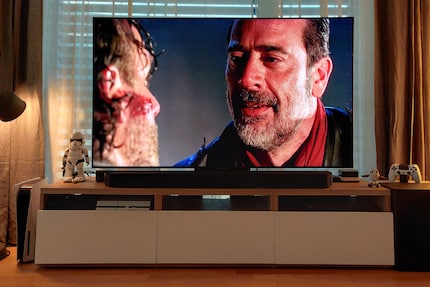
Source: Netflix, HD SDR quality. Timestamp: 00:02:30
It’s a good first impression, certainly as far as the details go. I already noticed this with other UHD material. All the same, I’m surprised the Q95T handles these scenes so well. But I’m excited to see the LG-GX-comparison, which is my upscaling favourite so far.
But first, here's a snapshot of the Samsung’s Q95T:

Source: January 2021
Yip, it confirms the whole thing about the details. Pay attention to Negan’s stubble around his chin and mouth. The background looks clean; there’s no noise. It looks a lot worse on other manufacturers’ models. For example, on the TCL, whose processor already came under criticism in my review.
And now here’s LG’s GX, which is currently the best TV on the market:

Source: August 2020
The full black of the OLEDs gives the image more saturation. There’s more punch. LG is also better at displaying the contours and offers a bit more detail. In addition, there’s visibly less noise in the background between the two men. Although that could be down to the slight black crush, which swallows up the noise along with a few too many details from Negan’s face.
Let’s have a look at two more manufacturers.


Source: July 2020
Do you see what I mean about noise in the background? It’s absolutely intentional from the makers, but Samsung and LG have such strong processors that they just gloss over it.
But the scene is great for testing out and comparing different models.
Perfectly acceptable sound and proven operating system
What’s the sound system like? Put it like this, I hardly noticed it. Certainly not in a negative way, which is a good sign. I normally find sound systems built into narrow TV panels an absolute headache. The sound is usually hollow and tinny. The Philips OLED805 was a pleasant exception. The same with the Samsung Q95T.
Taking a closer look at the system, it’s comprised of two 10 W speakers at the top and bottom of the screen edge along with two 10 W subwoofers. All in all, it's a 2.2.2 sound system. This ensures comparatively good crashes and sounds in general that actually seem like they come from the middle of the screen. But I don't notice much from the lauded «Object Tracking Sound» (OTS). Much like Sony’s Acoustic Surface, it’s meant to ensure that an object that’s coming from the left side of the image truly does sound like it’s coming from that direction.
Surround sound, basically.
Nice try. But the Q95T doesn't replace a real surround sound system. Thanks to the additional eARC HDMI channel on the OneConnect box (HDMI 3), you can still send loss-free audio signal from the TV to a soundbar or receiver – Dolby Atmos, for example. The TV speakers can’t handle it on their own.
Let’s finish with a final note on the operating system, Tizen OS. Hardly anything about it has changed. Similar to LG’s WebOS, in Tizen OS, apps such Netflix, Prime Video, Disney+ and AppleTV open in tiles at the bottom edge of the screen. Samsung’s good processor means apps open fast without juddering. While I was putting Tizen through its paces for this review, it only really crashed once. The single thing that helped was unplugging it and switching it back on again.
Was Samsung too tentative?
The Q95T is a good TV. A very good one, in fact. But there’s something niggling at me. I get the feeling Samsung didn’t give its 2020 UHD flagship everything it had. I’m thinking about the number of dimming zones being halved. Or the incredibly restrained local dimming.
In this case, it’s not less is more but rather, more would have been more. In my opinion, at least. But did Samsung deliberately hold back with this launch to make their 8K line up look better, as some people are suggesting? It sounds a bit far-fetched to me. After all, it’s not as if Samsung gets bonus points when reviewers like me get worked up about something like that.
But I can’t think of another logical explanation. It’s just a shame that Samsung isn’t seeing out its last FALD technology flagship with a bang. This year marks the first time the company will be launching its own mini-LED product. In terms of image quality, I’m not expecting anything other than – wait for it, pun incoming – quantum leaps.
Ha. Maybe I should have worked in marketing.
I write about technology as if it were cinema, and about films as if they were real life. Between bits and blockbusters, I’m after stories that move people, not just generate clicks. And yes – sometimes I listen to film scores louder than I probably should.

